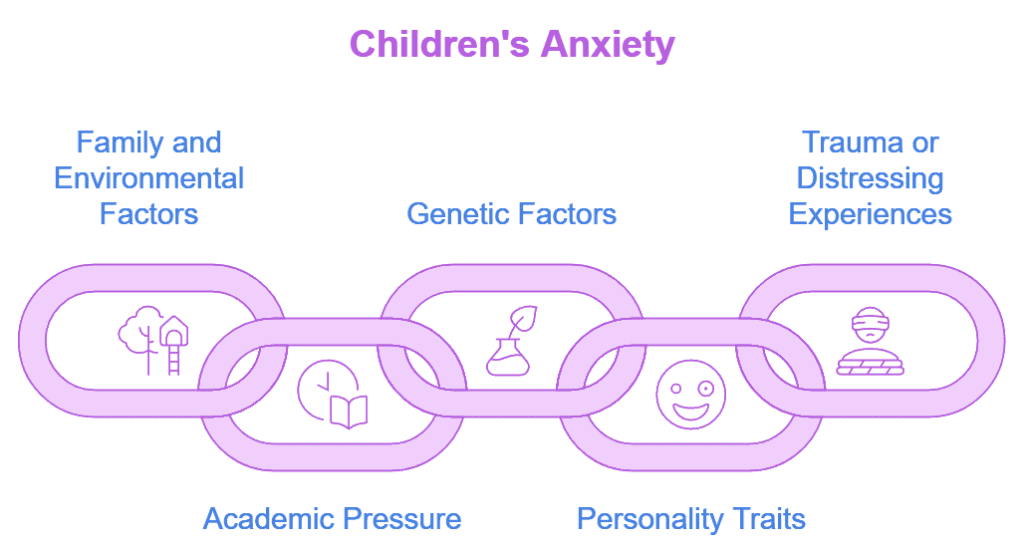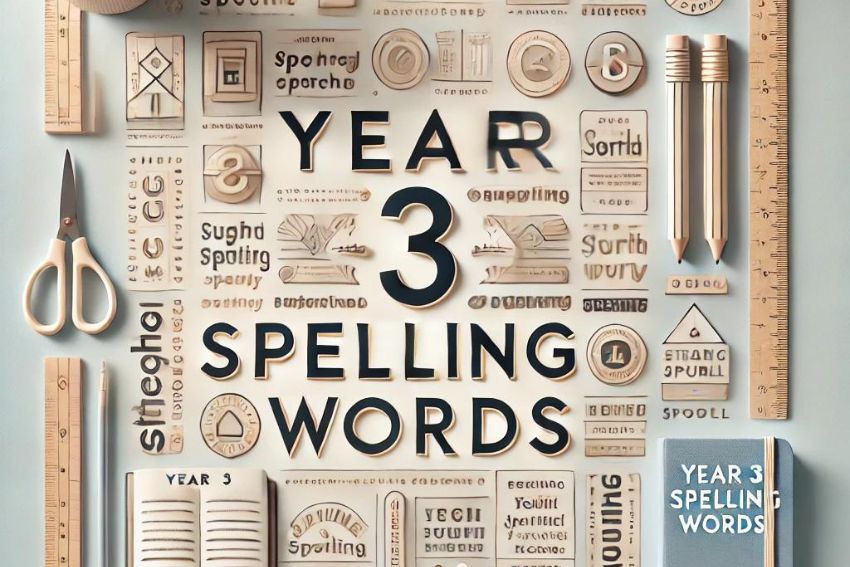Childhood anxiety, meanwhile, is a concern that many parents face, often feeling unsure of how to identify or address it. Notably, anxiety in children can manifest differently from adults, and recognising the early signs is, therefore, crucial for supporting a child’s emotional well-being. In this guide, we aim to equip parents with essential knowledge about childhood anxiety, its symptoms, and practical ways to support their child. Furthermore, we provide a childhood anxiety symptoms checklist with clear explanations and actionable steps.
In addition, this blog is designed to help parents by covering essential signs and symptoms, offering insights on how to approach your child if they’re struggling, and sharing strategies for handling anxiety constructively. Ultimately, our goal is to provide a comprehensive resource that supports you through every step, from early recognition to seeking professional help if needed.
What is Anxiety?
Anxiety is a natural response to stress or danger, often manifesting as a combination of physical sensations, emotional distress, and behavioural changes. While it is normal to experience anxiety occasionally, persistent or intense anxiety, especially in children, can interfere with daily life and development. When anxiety becomes a constant state, it may lead to avoidance behaviours, difficulty focusing, or intense emotional responses. Understanding anxiety as a blend of physical, emotional, and behavioural symptoms can help you approach your child’s experiences with empathy.

Childhood Anxiety Symptoms Checklist
We provide a childhood anxiety symptoms checklist for parents, so you can more accurately recognize signs on early stage. By that you will be able to take early action to support them. Here are some common indicators of anxiety in children:
Physical Symptoms
- Frequent Headaches or Stomach Aches: Unexplained physical complaints are common with anxiety.
- Muscle Tension and Fatigue: Constant worry can lead to tension and feelings of exhaustion.
- Sleep Issues: Difficulty falling or staying asleep, frequent nightmares, or reluctance to sleep alone.
Emotional Signs
- Excessive Worry or Fear: Persistent fears, especially around family, friends, school, or health.
- Irritability and Mood Swings: Increased frustration, anger, or sadness without obvious cause.
- Avoidance of Worrisome Topics: Unwillingness to discuss specific subjects or situations that may provoke anxiety.
Behavioural Changes
- Avoiding Social Situations: Reluctance to engage in social activities or interact with peers.
- Clinginess: Becoming overly dependent on caregivers or refusing to separate from family members.
- Avoidance of New Experiences: Fear or hesitance around trying new activities, attending events, or meeting new people.
Cognitive Symptoms
- Difficulty Concentrating: Struggling to focus on schoolwork or other tasks due to anxious thoughts.
- Negative Self-Talk: Constantly expressing self-doubt or worry about failure and rejection.
- Overthinking and Obsessive Thoughts: Repeatedly thinking about “what if” scenarios or worst-case outcomes.
School-Related Symptoms
- Declining Academic Performance: Anxiety can affect schoolwork due to difficulty concentrating or motivation issues.
- Frequent Absenteeism: Avoiding school as a way to escape stressful or anxiety-inducing environments.
- Perfectionism: Setting unrealistic standards, resulting in distress when these goals aren’t met.
Reasons Why Children May Experience Anxiety

Children can feel anxious for many reasons, frequently influenced by a combination of environmental, genetic, and psychological factors. By recognising these underlying causes, parents and caregivers can, in turn, gain a better understanding of what might be contributing to their child’s anxiety and, therefore, provide more targeted support. Consequently, here are some common reasons why children may experience anxiety:
Family and Environmental Factors
- Parental Anxiety: Children are sensitive to their parents’ emotions. If a parent frequently displays signs of anxiety, a child may unconsciously adopt similar behaviours and thought patterns.
- Family Conflicts or Divorce: Situations such as arguments, separation, or divorce can create a sense of insecurity, leading to increased anxiety about family stability.
- Stressful Life Events: Major changes like moving house, starting a new school, or experiencing a loss in the family can trigger anxiety in children who may struggle with adapting to change.
Academic Pressure
- Schoolwork and Exams: High expectations from parents or school, fear of failing, or pressure to perform well in school can make children anxious, particularly as they get older and face exams or assessments.
- Social Interactions: School can be a challenging environment for some children, especially if they experience bullying, struggle with friendships, or feel socially excluded, all of which can contribute to social anxiety.
Genetic Factors
- Family History of Anxiety Disorders: Children with a family history of anxiety disorders or mental health issues are more likely to experience anxiety themselves, suggesting a genetic predisposition towards heightened anxiety responses.
Personality Traits
- Sensitivity and Perfectionism: Children who are naturally sensitive or perfectionistic may have a heightened tendency to worry about things they can’t control or may feel immense pressure to meet their own high standards, leading to anxiety when they fall short.
Trauma or Distressing Experiences
- Abuse or Neglect: Experiencing abuse, neglect, or any traumatic event (such as a car accident or witnessing violence) can result in heightened anxiety, often manifesting as Post-Traumatic Stress Disorder (PTSD) or other anxiety-related symptoms.
- Medical Conditions and Hospitalisations: Health issues or long-term medical treatments can make children anxious about their bodies, pain, and even fear of mortality, especially if they’ve experienced medical trauma.
Excessive Exposure to Media
- News and Social Media: Being exposed to disturbing news stories or witnessing distressing images on social media can create fear and anxiety in children, who may not fully understand the context but feel a sense of impending threat or danger.
Developmental and Cognitive Factors
- Understanding of the World: As children grow, their awareness of the world and its potential dangers increases. This developing understanding, combined with limited coping skills, can lead to fears and anxieties about situations they once ignored, such as illness, death, or failure.
- Overthinking and Worrying: Some children may develop a habit of overthinking situations, especially if they lack problem-solving skills. This tendency can lead to a cycle of worry and anxiety, often about scenarios that are unlikely or out of their control.
Understanding these factors can help you identify potential anxiety triggers in your child’s life. Be observative, we assure you that by recognising these causes, you can create a more supportive environment that encourages positive coping mechanisms and reduces anxiety-inducing situations where possible.
What Is The Difference Between Casual Anxiety and Anxiety Disorder?
Casual anxiety is a common and temporary reaction to stressful or unfamiliar situations, such as a school exam or meeting new people. It’s a normal part of life and generally fades once the event passes. Anxiety disorder, however, is a persistent, overwhelming state of worry that can occur without an immediate cause. It affects daily activities, school performance, social interactions, and overall quality of life. Unlike casual anxiety, an anxiety disorder doesn’t diminish easily, often requires professional intervention, and is managed with strategies tailored to reduce symptoms over time, supporting a child’s emotional well-being and development.

Anxiety Disorders in Children and Teenagers
Anxiety disorders are among the most common mental health issues faced by children and teenagers. These disorders can significantly impact a young person’s daily life, influencing their ability to engage in social activities, perform academically, and manage personal relationships. While some anxiety is a normal part of childhood, excessive or persistent anxiety can lead to debilitating feelings that interfere with development and well-being.
Understanding the various types of anxiety disorders that can affect young people is crucial for parents, educators, and caregivers. By recognising the signs and symptoms, we can provide appropriate support and interventions to help children navigate their anxiety and lead fulfilling lives. Below are the common types of anxiety disorders that children and teenagers may experience, each defined to enhance understanding and awareness.
Here’s a list of common types of anxiety that children and teenagers may experience, along with brief definitions of each type:
Generalised Anxiety Disorder (GAD)
Children with GAD experience excessive worry about a wide range of everyday situations, including school performance, family issues, friendships, and health. The worry often seems disproportionate to the actual event and can lead to physical symptoms such as headaches, stomach aches, and fatigue. GAD can make a child feel persistently anxious, even when there is no immediate problem.
Social Anxiety Disorder
Social anxiety disorder causes intense fear and avoidance of social situations, often due to worries about being embarrassed, judged, or rejected by others. Children with social anxiety may avoid speaking in front of the class, struggle with group activities, or refuse to attend events where they might need to interact with others. This can lead to isolation and impacts social development.
Separation Anxiety Disorder
Separation anxiety disorder is characterised by excessive fear of being away from home or primary caregivers, such as parents. This type of anxiety is more common in younger children but can also affect older children and teens. It often manifests as intense worry that something bad will happen to them or their loved ones when apart, leading to refusal to attend school, sleepovers, or other activities away from family.
Specific Phobias
Specific phobias are intense, irrational fears of particular objects or situations, such as animals, heights, storms, or the dark. A child with a specific phobia may go to great lengths to avoid encountering the feared object or situation, even if it causes disruption in daily life. Unlike general fears, phobias are severe and often interfere with a child’s activities.
Panic Disorder
Panic disorder, on the one hand, involves sudden and intense episodes of fear, known as panic attacks, which may include symptoms such as a racing heart, dizziness, shortness of breath, and a sense of impending doom. Consequently, children or teens with panic disorder may develop a fear of having panic attacks. As a result, they often avoid situations they associate with past attacks, ultimately creating a cycle of anxiety.
Obsessive-Compulsive Disorder (OCD)
OCD is characterised by recurring, intrusive thoughts (obsessions) and repetitive behaviours (compulsions) performed to alleviate the anxiety associated with these thoughts. For example, a child might wash their hands repeatedly due to fear of germs, or feel compelled to check and recheck that doors are locked. OCD can interfere with daily routines, schoolwork, and relationships.
Post-Traumatic Stress Disorder (PTSD)
PTSD can develop after a child or teenager experiences or witnesses a traumatic event, such as an accident, natural disaster, or abuse. Symptoms include flashbacks, nightmares, avoidance of reminders of the trauma, and hypervigilance. PTSD in children can manifest through behavioural changes, mood swings, and physical symptoms like headaches or stomach aches.
Selective Mutism
Selective mutism is an anxiety disorder in which a child consistently fails to speak in specific social situations where speaking is expected, such as school or public places, despite being able to speak comfortably in other settings (like at home). This condition often overlaps with social anxiety and can hinder a child’s social and academic development.
Each type of anxiety disorder has its unique features but shares the common trait of persistent and often overwhelming worry. Recognising the signs of these specific anxiety disorders can help parents seek the right support for their child, whether through professional guidance or targeted coping strategies.
What Happens If We Don’t Treat Anxiety In Children?
Untreated anxiety in children and teenagers can lead to serious, lasting consequences affecting their mental, emotional, and physical well-being. Persistent anxiety often interferes with daily life, leading to avoidance of school, friendships, and new experiences. Over time, it can contribute to low self-esteem, social isolation, and academic decline.
Untreated anxiety also increases the risk of developing additional mental health conditions, such as depression, substance misuse, or even self-harming behaviors. The effects of chronic anxiety can extend into adulthood, impacting future relationships, career opportunities, and overall life satisfaction. Early intervention and support are essential to help children manage anxiety effectively, building resilience and a positive outlook for the future.
How to Manage Anxiety in Children?

If you don’t know how to help your child and manage his or her anxiety, you don’t have to worry because we got you! First of all, helping a child manage anxiety involves providing them with a safe, supportive environment and teaching them practical coping skills. Remember, Parents play a crucial role in guiding children through their anxiety, enabling them to face challenges with confidence and resilience. Here are some effective ways you can use to support your child:
Create a Safe and Supportive Environment For Your Child
- Open Communication: Encourage your child to talk about their feelings without fear of judgment. Regularly ask open-ended questions like, “What was the best and hardest part of your day?” to help them feel comfortable expressing emotions.
- Validate Their Feelings: Let your child know it’s okay to feel anxious or scared. Validating their emotions without dismissing or minimising them helps children understand that feelings are normal and manageable.
- Establish Routine and Consistency: Children feel more secure when their daily life is predictable. Establishing a routine for school, homework, play, and bedtime creates structure and stability, reducing anxiety that can arise from uncertainty.
Teach Them Coping Skills
- Encourage Problem-Solving: Help your child identify their worries and think through solutions or actions they can take. This approach not only addresses the current issue but also builds resilience for handling future challenges.
- Develop Positive Self-Talk: Teach your child to replace anxious thoughts with positive affirmations. For example, if they’re worried about an exam, encourage them to say, “I’ve prepared, and I’ll do my best,” instead of focusing on fears of failure.
- Model Calmness: Children often look to their parents for cues on handling stressful situations. By demonstrating calm behaviour in challenging moments, you show your child how to stay composed when they feel anxious.
Practice Relaxation Techniques with them
- Deep Breathing Exercises: Teach your child to take slow, deep breaths to calm their body and mind. For younger children you can try, a simple exercise “smell the flower, blow out the candle,” where they imagine smelling a flower (inhale) and blowing out a candle (exhale).
- Progressive Muscle Relaxation: This technique involves tensing and relaxing each muscle group in the body, starting from the feet and working up to the head. It helps children release tension and feel more at ease.
- Mindfulness and Visualisation: Guided imagery, like imagining a peaceful place (such as a beach or a forest), can help children focus on calming thoughts instead of anxious ones. Apps and children’s meditation videos are useful resources for teaching these techniques.
Encourage Healthy Habits In Your Children
- Regular Exercise: Physical activity releases endorphins, which help to reduce anxiety and improve mood. Encourage your child to engage in activities they enjoy, such as swimming, dancing, or simply playing outside.
- Balanced Nutrition: A balanced diet with regular meals stabilises blood sugar levels, which can help reduce irritability and anxiety. Limiting sugary snacks and caffeine (even from soda) is also beneficial.
- Adequate Sleep: Sleep is essential for mental and emotional health. Set a regular bedtime routine and ensure your child gets adequate rest, as fatigue can heighten feelings of anxiety.
- Limit Screen Time: Reducing screen time, especially before bed, can improve both sleep quality and mental health. Encourage relaxing activities like reading or drawing in place of screen time to help your child wind down.
By creating a supportive environment, teaching effective coping strategies, and encouraging relaxation and healthy habits, parents can help their child navigate and manage anxiety in a positive way. Remember, consistency and patience are key—over time, these strategies can empower your child to face challenges with confidence and resilience.
Additional Tips to Ease Anxiety in Children?
After figuring out main ways to manage children’s anxiety, we want to provide other ways to ease anxiety in them. Here’s a checklist of simple but effective ways to reduce anxiety in children, along with explanations for each approach:
Limit Exposure to Stressful Media
News and social media can expose children to topics they’re not ready to process, leading to worry and stress. Limiting exposure to age-appropriate content can reduce feelings of anxiety about events outside their control.
Encourage Expression Through Creative Outlets
Activities like drawing, painting, journaling, or storytelling provide children with a safe space to express their feelings in non-verbal ways. Creative outlets can help them release pent-up emotions and feel more relaxed.
Engage in Regular Physical Activity Together
Exercise is a natural anxiety reliever, as it releases endorphins that boost mood. Activities like biking, hiking, or playing games outside also serve as bonding time and help children expend anxious energy in a healthy way.
Set Small, Achievable Goals
Breaking down big tasks into smaller, manageable steps can help children feel less overwhelmed. Setting realistic goals for schoolwork or chores and celebrating small accomplishments builds confidence and reduces anxiety about failure.
Create a “Worry Box”
Have your child write down their worries and place them in a designated box. This exercise encourages them to let go of their worries, knowing they’re safely “stored away,” and can help prevent anxious thoughts from building up.
Schedule ‘Worry Time’
Designate a specific time during the day for your child to talk about their worries (e.g., 10 minutes before dinner). This allows them to express their concerns without letting anxiety take over the whole day and provides structure to help them process emotions.
Offer Choices to Build Confidence
Allowing children to make small decisions, like choosing their clothes or planning a family activity, gives them a sense of control. This helps reduce anxiety by empowering them to feel capable of handling challenges.
Model Self-Compassion and Positive Self-Talk
Demonstrating self-kindness when you make a mistake or feel stressed teaches children that it’s okay to be imperfect. This practice helps them develop a kind inner voice, which is crucial for managing anxiety and reducing self-criticism.
Encourage Practising Gratitude
Gratitude exercises, such as listing three things they’re thankful for each day, can shift a child’s focus from worries to positive aspects of their life. This habit can help reduce overall anxiety and improve mood.
Introduce Positive Visualisation Techniques
Visualisation involves imagining a safe, calm place where they feel happy, like a beach or their favourite park. This technique provides an escape for children during anxious moments and helps them relax by creating a sense of calm within themselves.
Provide Comfort Items
A favourite blanket, stuffed animal, or even a family photo can provide comfort during anxious moments. These items act as a grounding tool, offering a sense of familiarity and security when they feel uneasy.
Encourage Friendships and Social Connections
Spending time with friends helps children feel supported and less isolated. Encourage playdates, group activities, or team sports to build social confidence, which can reduce social anxiety and foster resilience.
Each of these strategies, therefore, helps reduce anxiety in different ways, ranging from building resilience and self-esteem to providing relaxation and comfort. By incorporating these approaches, parents can, in turn, empower their child to manage anxiety more effectively.

How To Help My Child With Academic Anxiety?
Every parent knows that, academic pressure can create significant anxiety in children and even in teenagers too, impacting their emotional well-being and performance. Here are effective ways for parents to support their child through these challenges:
Emphasise Effort Over Perfection
- Encourage a Growth Mindset: Teach your child that learning and growth are more important than achieving perfect results. Praise their effort and resilience, helping them understand that mistakes are part of the learning process.
Set Realistic Expectations
- Discuss Goals Together: Work with your child to set achievable, realistic academic goals. Avoid pressuring them for high grades only, focusing instead on their overall development and understanding of subjects.
Provide Organisational Support
- Help Them Plan: Teach time management and organisational skills, such as using a planner or creating a study schedule. Breaking tasks into smaller steps makes large assignments feel manageable, reducing anxiety.
Encourage Healthy Study Habits
- Take Breaks and Set Boundaries: Encourage short breaks during study sessions to refresh focus and avoid burnout. Limiting study time before bedtime also helps, as sleep is essential for mental resilience.
Practise Relaxation Techniques
- Teach Breathing and Mindfulness Exercises: Simple techniques, like deep breathing or mindful meditation, can help them relax before exams or during stressful study periods. Apps like Calm or Headspace offer guided practices for teens.
Create a Low-Pressure Environment at Home
- Avoid Comparing with Peers: Remind them that everyone learns at their own pace. Comparing them to others can heighten pressure and lower self-esteem, so focus on their personal progress instead.
Normalise Talking About Anxiety
- Encourage Open Conversations: Let your child know it’s okay to feel anxious. Create a safe space where they can express worries about schoolwork without fear of disappointment or judgment.
Seek Additional Support if Needed
- Explore Tutoring or Counselling: If anxiety significantly impacts their performance, consider reaching out for academic support or counselling. School counsellors, online tutors, or mental health professionals can provide guidance tailored to managing academic stress.
By fostering an understanding, supportive environment, parents can help children and teenagers develop the resilience and strategies needed to manage academic anxiety and achieve a healthy balance.
Importance of Professional Help in Easing Anxiety in Children
While home-based strategies and a supportive environment are invaluable, some children may need professional support to manage their anxiety effectively. Professional intervention can provide specialised tools and therapies tailored to a child’s specific needs, helping them address their anxiety with guidance from experienced practitioners. Recognising when to seek professional help is crucial, particularly if the anxiety interferes with daily life, school performance, or relationships.
Who Can Help My Child’s Anxiety Problems?
- General Practitioners (GPs)
- GPs are often the first point of contact. They can assess the child’s symptoms, offer advice, and, if needed, refer them to a specialist for further support.
- How They Help: GPs can recommend treatments, monitor progress, and make referrals to child mental health services such as CAMHS
- Child and Adolescent Mental Health Services (CAMHS)
- CAMHS is the primary mental health service for children and young people in the UK, providing specialised care and support for those with emotional and behavioural difficulties.
- How They Help: CAMHS offers counselling, psychotherapy, cognitive behavioural therapy (CBT), and other treatments. They work with families and schools to develop a comprehensive care plan.
- Counsellors and Child Psychologists
- These professionals specialise in understanding and treating mental health issues in children. Many counsellors use approaches like play therapy, art therapy, and CBT to help children manage anxiety.
- How They Help: Counsellors and psychologists can provide regular sessions to help children explore their feelings and develop coping strategies.
- School Counsellors and Pastoral Support
- Many schools in the UK have counsellors or pastoral staff trained to support students with mental health challenges.
- How They Help: School counsellors provide a familiar, accessible resource where children can discuss their feelings in a safe and non-judgmental space. They may also refer students to external mental health services if more intensive support is needed.
Where Parents Can Seek Help For Their Children’s Anxiety Problems?
- NHS Child Mental Health Services
- Access: Parents can speak to their GP for a referral to NHS mental health services or contact CAMHS directly if urgent.
- Availability: The NHS offers various mental health services specifically for children, including in-person and online support.
- Counselling Services and Organisations
- YoungMinds: Provides mental health resources and has a parent helpline (0808 802 5544) for advice on supporting children.
- Place2Be: Offers counselling services in schools across the UK, helping children access support within a familiar setting.
- The British Association for Counselling and Psychotherapy (BACP): BACP’s directory includes qualified child counsellors and therapists, allowing parents to find professional support locally or online.
- Telephone and Online Help
- Childline (0800 1111): A confidential helpline for children and young people, offering free phone and online support. They also have online chat services and resources.
- SHOUT (Text 85258): A free, confidential, 24/7 text service for anyone struggling to cope, including young people with anxiety. Run by trained volunteers.
- Samaritans (116 123): A helpline available 24/7 for people of all ages who need support, including children and teenagers. They also offer email support.
Other Helpful Online Resources, Books, and Websites
Websites and Apps
- YoungMinds: Offers a comprehensive range of resources, including articles, videos, and guides for both children and parents.
- MindEd: A free online resource from the NHS, providing information on child mental health for parents, carers, and teachers.
- Headspace for Kids: Offers mindfulness and relaxation exercises specifically for children, accessible via a mobile app.
Books for Parents
- “Helping Your Anxious Child” by Ronald M. Rapee is a practical guide with step-by-step strategies to help children overcome anxiety.
- “What to Do When You Worry Too Much: A Kid’s Guide to Overcoming Anxiety” by Dawn Huebner is a child-friendly workbook that uses engaging activities to teach coping skills.
- “The Whole-Brain Child” by Daniel J. Siegel and Tina Payne Bryson offers strategies based on neuroscience for helping children manage difficult emotions, including anxiety.
Books for Children
- “The Huge Bag of Worries” by Virginia Ironside: A picture book that helps young children understand and talk about their worries.
- “The Worry Workbook for Kids” by Muniya Khanna and Deborah Roth Ledley: This workbook contains exercises that help children aged 7-12 identify and manage their worries.
- “My Anxious Mind” by Michael A. Tompkins and Katherine A. Martinez: A guide for older children and teens, offering practical advice and exercises to handle anxiety.
- Support for Parents and Caregivers
- Anxiety UK: Provides resources, support groups, and information specifically about managing anxiety in children and adults.
- Family Lives: A UK charity offering online support for parents, including forums, articles, and advice on child mental health and anxiety.
Professional help, therefore, can offer valuable insights and tailored support for managing childhood anxiety. By actively working alongside mental health professionals and utilising available resources, parents can, in turn, provide a more comprehensive support network, ultimately giving children the best possible chance to overcome anxiety and thrive.
Conclusion
Recognising the symptoms of childhood anxiety is a vital first step in providing effective support. By using a childhood anxiety symptoms checklist of signs, parents and caregivers can identify early indicators of anxiety, helping children feel understood and supported. While some anxiety is natural, persistent symptoms signal a need for more targeted support, including healthy coping mechanisms and potentially professional guidance. By being attentive to their child’s needs and proactive in seeking resources, parents can play a significant role in reducing anxiety, building resilience, and fostering a foundation of emotional well-being that supports healthy development and a positive outlook on life. Good Luck!








